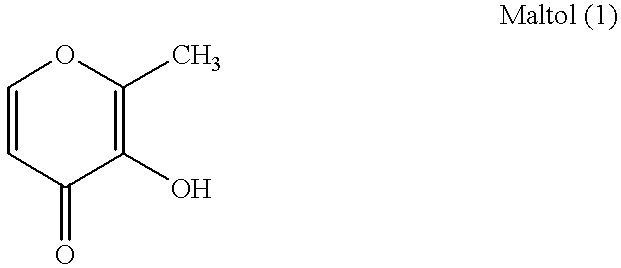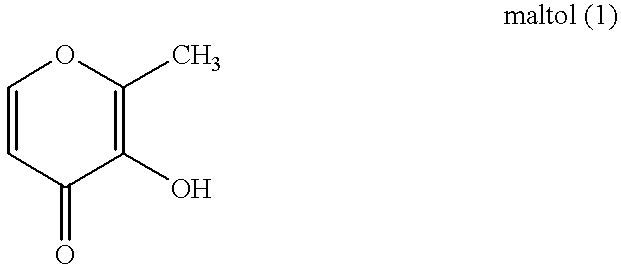Process for the preparation of maltol from plants belonging to the genus Abies
a technology of abies and maltol, which is applied in the direction of plant/algae/fungi/lichens ingredients, heterocyclic compound active ingredients, biocide, etc., can solve the problems of high cost of use of resulting maltol, inability to achieve the effect of reducing the solubility of maltol in ethylene glycol at ambient temperature, and complex existing techniques
- Summary
- Abstract
- Description
- Claims
- Application Information
AI Technical Summary
Problems solved by technology
Method used
Image
Examples
example 1
Air-dried pulverized leaves of the plant Abies pindrow (1 kg) were extracted with MeOH (3 lit.times.3) at 20-40.degree. C. for three days. MeOH was concentrated under vacuum and the MeOH ext. was adsorbed with celite (600 g.) and the adsorbed material was dried at 20-50.degree. C. for 4-12 hours. The adsorbed material was then extracted with petroleum ether (60-80.degree. C.) (1 lit.times.3) and chloroform (1 lit.times.3) successively. Chloroform extract was concentrated under vacuum to a residue and it crystallized out. The crystals were filtered and re-crystallized from petroleum ether-chloroform mixtures to give maltol as needles, yield, 5 grams.
example 2
Air-dried, pulverized leaves of the plant Abies pindrow (1 kg) were extracted with EtOH (3 lit.times.3) at 20-40.degree. C. for three days. EtOH was concentrated under vacuum and the EtOH ext. was adsorbed with cellulose (600 g.) and the adsorbed material was dried at 20-50.degree. C. for 4-12 hours. The adsorbed material was then extracted with hexane (1 lit.times.3) and dichloromethane (1 lit.times.3) successively. Dichloromenthane extract was concentrated under vacuum to a residue and it crystallized out. The crystals were filtered and re-crystallized from acetone-petroleum ether to give maltol as needles, yield, 5.1 grams.
example 3
Air-dried, pulverized leaves of the plant Abies pindrow (1 kg) were extracted with MeOH (3 lit.times.3) at room temperature for three days. MeOH was concentrated under vacuum and the MeOH ext. was adsorbed with a mixture of cellulose--celite (600 g.) and the adsorbed material was dried at room temperature. The adsorbed material was then extracted with petroleum ether (60-80.degree. C.) (1 lit.times.3) and chloroform (1 lit.times.3) successively. Chloroform extract was concentrated under vacuum to a residue and it crystallized out. The crystals were filtered and re-crystallized from petroleum ether-dichloromethane mixture as to give maltol as needles, yield, 5 grams.
PUM
| Property | Measurement | Unit |
|---|---|---|
| temperature | aaaaa | aaaaa |
| temperature | aaaaa | aaaaa |
| aliphatic | aaaaa | aaaaa |
Abstract
Description
Claims
Application Information
 Login to View More
Login to View More - R&D
- Intellectual Property
- Life Sciences
- Materials
- Tech Scout
- Unparalleled Data Quality
- Higher Quality Content
- 60% Fewer Hallucinations
Browse by: Latest US Patents, China's latest patents, Technical Efficacy Thesaurus, Application Domain, Technology Topic, Popular Technical Reports.
© 2025 PatSnap. All rights reserved.Legal|Privacy policy|Modern Slavery Act Transparency Statement|Sitemap|About US| Contact US: help@patsnap.com


